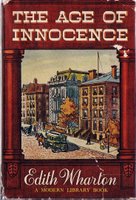 Book Nine of ’05: The Age of Innocence, Edith Wharton.
Book Nine of ’05: The Age of Innocence, Edith Wharton. It is the account of Old New York that is most important. For the love story, ineffable and bittersweet, takes its shape and meaning from the structure of society. Society brings the couple—Newland Archer and the Countess Olenska—together, yet also serves to keep them eternally apart.
Wharton’s writing is elegant and precise. Late in the novel, after Archer and his wife, May, have talked elliptically about Madame Olenska, May leaves the room “her torn and muddy wedding-dress dragging after her across the room.” That single image aptly and startlingly captures the state of the couple’s marriage.
Wharton exposes the nuances of
Two fine passages:
“I want—I want somehow to get away with you into a world where words like that—categories like that—won’t exist. Where we shall be simply two human beings who love each others, who are the whole of life to each other; and nothing else on earth will matter.”
She drew a deep sigh that ended in another laugh. “Oh, my dear—where is that country? Have you ever been there?” she asked; and as he remained sullenly dumb she went on: “I know so many who’ve tried to find it; and believe me, they all got out by mistake at wayside stations . . . and it wasn’t at all different from the old world they’d left, but only rather smaller and dingier and more promiscuous.”
--
“Now he saw the matter in a new light, and his part in it seemed singularly diminished. It was, in fact . . . a smiling, bantering, humouring, watchful and incessant lie. A lie by day, a lie by night, a lie in every touch and every look; a lie in every caress and every quarrel; a lie in every word and in every silence.
It was easier, and less dastardly on the whole, for a wife to play such a part toward her husband. A woman’s standard of truthfulness was tacitly held to be lower: she was the subject creature, and versed in the arts of the enslaved. Then she could always plead moods and nerves, and the right not to be held too strictly to account; and even in the most strait-laced societies the laugh was always against the husband.”


No comments:
Post a Comment